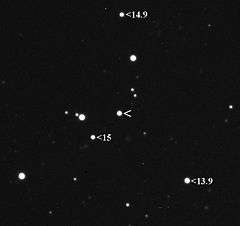153 Hilda
|
Star field showing Hilda (apmag 14.2) | |
| Discovery[1] | |
|---|---|
| Discovered by | J. Palisa |
| Discovery date | 2 November 1875 |
| Designations | |
| Main belt (Hilda) | |
| Orbital characteristics[1] | |
| Epoch 31 July 2016 (JD 2457600.5) | |
| Uncertainty parameter 0 | |
| Observation arc | 121.05 yr (44215 d) |
| Aphelion | 4.5341 AU (678.29 Gm) |
| Perihelion | 3.4225 AU (512.00 Gm) |
| 3.9783 AU (595.15 Gm) | |
| Eccentricity | 0.13971 |
| 7.94 yr (2898.3 d) | |
| 51.690° | |
| 0° 7m 27.156s / day | |
| Inclination | 7.8249° |
| 228.16° | |
| 38.617° | |
| Earth MOID | 2.41154 AU (360.761 Gm) |
| Jupiter MOID | 0.569657 AU (85.2195 Gm) |
| Jupiter Tisserand parameter | 3.023 |
| Physical characteristics | |
| Dimensions | 170.63±3.3 km[1] |
| Mass | ~5.2×1018 kg |
Equatorial escape velocity | ~ 6 m/s |
| 5.9587 h (0.24828 d)[1] | |
| 0.0618±0.002[1] | |
| C | |
| 7.48[1] | |
|
| |

153 Hilda is a large asteroid in the outer main belt, with a diameter of 170 km.[1] Because it is composed of primitive carbonaceous materials, it has a very dark surface. It was discovered by Johann Palisa on November 2, 1875, from the Austrian Naval Observatory at Pula.[1] The name was chosen by the astronomer Theodor von Oppolzer, who named it after one of his daughters.[2]
Orbit and family
Hilda gives its name to an asteroid group called the Hilda family (or Hildas for short). It is not a true asteroid family, since the members are not physically related, but rather share similar orbital elements. The Hildas are locked in a 2:3 orbital resonance with Jupiter;[3] since Jupiter takes 11.9 years to orbit the Sun while Hilda takes 7.9 years,[1] Jupiter orbits the Sun twice for every 3 orbits that Hilda completes. There are over 1,100 other objects known to be in a 2:3 resonance with Jupiter.[3]
Observations
Hilda was observed to occult a star on December 31, 2002, from Japan. It has a very low-amplitude light curve indicating a spherical body or a non-varying albedo.
Notes
- ↑ Based on orbital data from the year 2000. Hilda seldom approaches the Lagrangians exactly.
References
- 1 2 3 4 5 6 7 8 9 "JPL Small-Body Database Browser: 153 Hilda". 1998-02-12. Retrieved 12 May 2016.
- ↑ Lutz D. Schmadel, Dictionary of Minor Planet Names, p.29.
- 1 2 Brož, M.; Vokrouhlický, D. (2008). "Asteroid families in the first-order resonances with Jupiter". Monthly Notices of the Royal Astronomical Society. 390 (2): 715–732. Bibcode:2008MNRAS.tmp.1068B. doi:10.1111/j.1365-2966.2008.13764.x.
External links
- Orbital simulation from JPL (Java) / Horizons Ephemeris
- The triangle formed by the Hilda asteroids EasySky
- 153 Hilda at the JPL Small-Body Database

